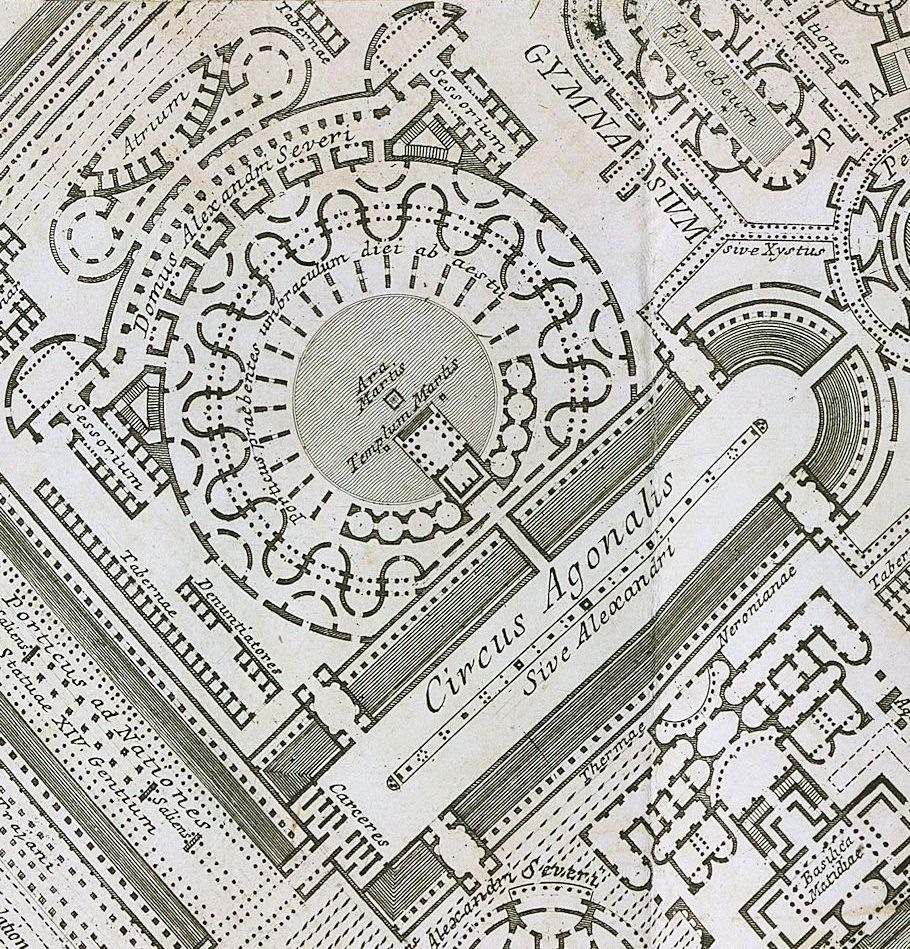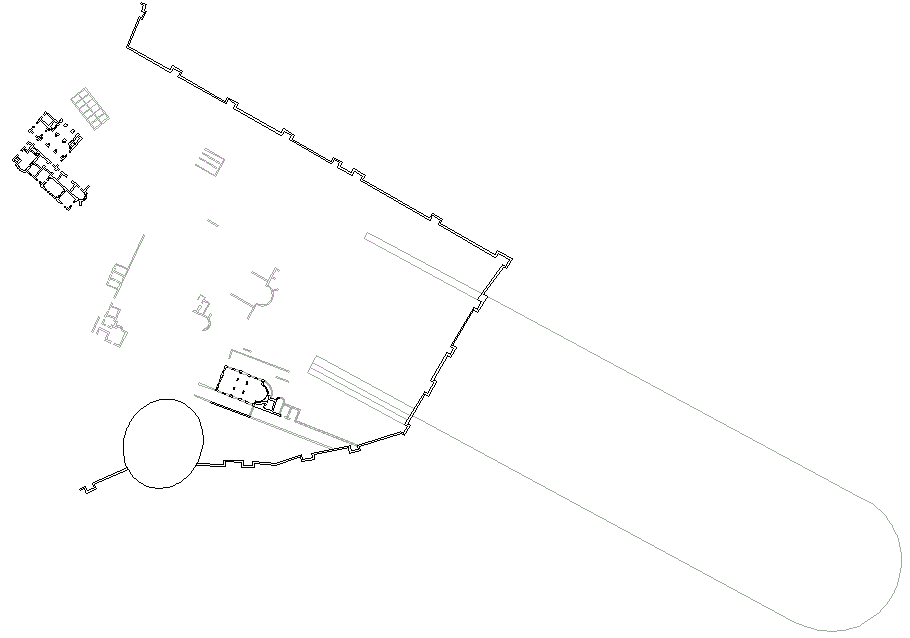18 August 751 BC
Rape of the Sabine women.
18 August
Feast of St. Helena
18 August 1778

Why did you put the Domus Alexandri Severi and two Sessorium along with the Circus Agonalis sive Alexandri all around the Ara Martis? The circus is in the right place, but the Domus Alexandri Severi and the Sessorium were in a whole other part of Rome.
Well Laura, that's a very good question. You actually found some of my inverted clues.
Inverted clues? What are you talking about?
Read the Vita di Eliogabalo and Vita Severi Alexandri in the Historia Augusta. That should help you figure it all out. Which reminds me: if anyone knows where Francesco is, tell him to go to Santa Croce in Gerusalemme, before he comes back, to see if anyone's been digging around the circus out there.
18 August 1977
Arrived in Venice at 8:30.
Breakfast on the sea front under Cinzano umbrella. Slept in the afternoon. Others went to the beach, said it was dirty. Ate dinner with John, Ron, Tom, Mohammad.
[Piazza] San Marco at night was empty because it was raining. However, the life was still there because the arcades became tunnels of excited circulation. The restaurants on the sides supply music, not Musak but a small orchestra. It was almost unreality being surrounded by architecture, food, people, and music at once. It was like walking through a movie or a dream. But isn't that what life is supposed to be all about? Isn't that what makes life worth living? Why does it have to cost so much? Never mind!
The piazza (back part) is bounded by continuous repeating facades on three sides, with the last side open to San Marco Cathedral. It is a continuous arcade that is under the facades. Restaurants, tables and chairs, it's great. The facades are just screens for the piazza and life happens beneath them. There is no indication of what happens behind the facades, which is good because it then does not take away some attention from the piazza. In fact, it strengthens the piazza by making it more united, coherent.
18 August 1997
Campo Marzio - aerial perspectives and 3d modeling
Yesterday was the first time I generated aerial perspectives of the Campo Marzio plan data. The results were promising, and I see such perspectives being used within the "Campo Marzio today" section of the book. What the perspectives made most clear, however, is that I really should begin a 3-D construction of the plan data. The capability of generating perspectives (of either 2-D or 3-D) is already something that has not been possible before, and thus a new rendition of the Campo Marzio.
I have thought of a system whereby I begin the model constructions. Because of the standard copy mirror and copy rotate commands, I will extrude each building plan as an orthogonal entity. The extrusions will reach a height somewhere between 10 and 20 feet, and will include whatever building base or stairs are part of the individual building design. I will begin with the buildings already in the typology collection, and the 3-D databases will have the same layer structure (I question this now, however). Copies of the 3-D data will then be rotated into a master model database.
The base of the model will be a separate exercise. I will overlay the Campo Marzio with a new grid (750x810 ft. increments) and I will develop each parcel individually and each parcel will have contours (if applicable), and water depressions, and opaque differentiation of green versus road of paved surfaces. I am hoping that this piecemeal approach makes the work easier and more efficient. (I am also hoping to get into a routine where I finish at least one parcel and perhaps also one building model a day, at least for the month of September.)
As the work progresses, I hope to gain further insight into the design, and I hope to make significant additions to the knowledge of Piranesi's reconstruction. I just realized that I could compare the Philadelphia model with the Campo Marzio model (at least the buildings and the building footprints from the Philadelphia model). I also just thought that I could use Lightscape to attach the Nolli plan to the corresponding grid portions of the Campo Marzio. This will enable a very interesting overlay effect when the plan extrusions and the Nolli map as a base are seen together. This now makes it imperative to correctly coordinate the two plans.
I just thought that I should begin with a full rendition/experiment of a specific section of the Campo Marzio, very likely the upper right corner of the map. By completing this section as completely as possible, I will have a much better idea of the work ultimately involved.
Campo Marzio - contiguous elements
Yesterday I also did my first experimentation of looking at contiguous elements in context. I started with the Horti Neroniani and while the results were interesting, they were not all that easy to achieve, nor was the process systematic. Because of this, I have decided to pursue the study of contiguous elements on the basis of individual buildings and within an orthogonal orientation. From there I will copy and rotate the new results into context.
As per my note from 6.2/3.96, I will breakdown each building in stages and the final "plan" with contiguous elements and geometric outlines is the drawing that will be put into the overall context. (8.20.97: I just realized that the aim of my contiguous element map is not so much to look like a ruin, but to actually be the record of each distinct piece with the Ichnographia. That this map may also resemble a map of ruins will be of prime interest but that is not exactly what I will be trying to produce. The final map may actually become a real sign of the kernels of Piranesi's creativity and therefore may also reveal some of the plans overall mystery. We shall see.) Rather than being a random breakdown (like actual ruins), it will be a very methodical dissemination, and perhaps evocative of the idea of a "modern" ruin.
Again, I will begin the study/analysis of the contiguous elements using the typology databases. I am not sure, however, what the final database structure will be in terms of layers and buildings per database.
(8.20.97: I am beginning to see that I should always prepare contiguous elements before I create model extrusions, and somehow it seems that the two databases will actually perform best as one database, both as orthogonal and as master databases of the context (and I can always separate the databases as the get larger).
archiving the Campo Marzio notes and data
I am beginning to realize that many of my organizational worries pertaining to the Campo Marzio would be solved if I continually archived the data via html files. I just realized that what I want is documentation on every building within the plan.
18 August 2001
damnatio memoriae and palimpsest
In doing further (re)reading of material on Helena and other Neo-Flavians, in Drijvers' Helena Augusta (1992) on p. 49 there is a 'reprint' of inscription CIL X 678. This is the same evidence of damnatio memoriae where we have examples of both the dm of Crispus and Fausta. While there are more extant examples of the dm of Crispus, this is the only extant example of Fausta' dm. As I mentioned the other day, I went to look at all the Crispus and Fausta dms within the CIL at Temple U's library. Since those books are enormous, I only photocopied CIL X 678. There a fair amount of Latin commentary that goes with the inscription, and some of the commentary is (as I found out last night) translated in Drijvers' book.
Not only were the words FAUSTA and UXORI (wife) erased, but they were replaced with HELENAE and MATRI. Thus, not only do we have here an example of damnatio memoriae, but an example of palimpsest as well. Question: is it a fairly common occurrence within other examples of dm for there to be a palimpsest as well, or is this more part of 'rare' damnatio memoriae subset?
Since CIL X 678 is the only extant example of Fausta's dm, I wonder if it might also be of some significance that it is actually a dm plus palimpsest. For example, could it be that Fausta's 'erasure' from memory is integral with Helena's 'inscription' into memory. Of course, on the immediate level, this tight connection appears obvious, but I'm still looking for other aspects and explanations that may enhance the understanding here. To sharpen the focus, I'm aware that there are many examples of palimpsests within inscriptions, so I'm more interested in examples where specific names/persons manifest a damnatio memoriae plus palimpsest combination.
ps
I also read last night in Pohlsander's Helena: Empress and Saint (1995) on p. 151: "The feast of the Invention of the Cross was previously observed in the West on 3 May but was suppressed by Pope John XXIII in 1960." Could this be considered one of the new forms of damnatio memoriae, or is it an example of purging history of what didn't happen? Is there a name for the act of purging history of what didn't happen?
18 August 2022

12121001.db Thermae Helenae, Amphitheatrum Castrense, Basilica Sessorianum, Circus of Elagabalus
|